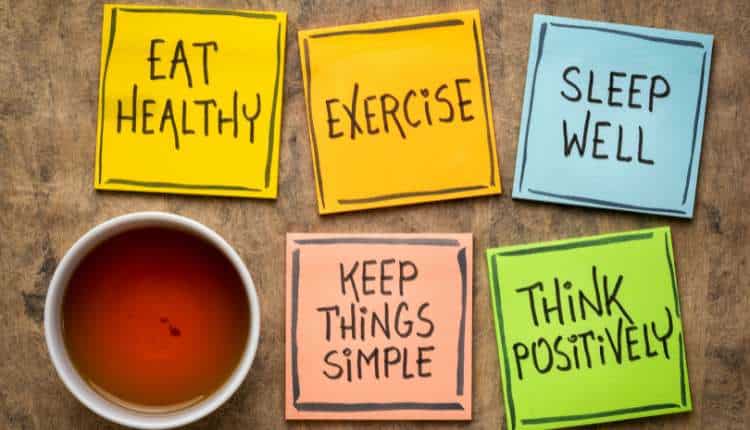
Health and wellness don’t come from a single good habit but rather a constellation of healthy habits that add up over time. In today’s health and fitness world, we’re flooded with information from a variety of sources. Sometimes we get so overloaded that it’s tempting to give up entirely.
There’s no need to surrender. Creating a healthy lifestyle is about building healthy habits. Exchanging bad habits for good adds up over time, and before you know it, you’ll find yourself on the road to health, wellness, and longevity.
1. Walk Every Day
Most of us have heard that 10,000 daily steps is the magic number, but don’t let that high number discourage you. Would it surprise you to know that the idea of 10,000 steps originated from a Japanese marketing campaign from the 1960s? The number of steps wasn’t based on a scientific study.
Science has now shown us that taking 7,500 steps per day provides most of the same benefits as walking 10,000 steps per day. In one study, women reduced their risk of mortality by 41% when they averaged just 4,400 steps per day.
Take a daily walk for 20 to 30 minutes and don’t worry about the number of steps. Enjoy yourself. Over time, the benefits of walking will add up.
2. Stay Hydrated
There are a lot of opinions when it comes to how much and how often you should drink. But there are a few things on which most experts agree, the most important being that you should drink water and stay well hydrated. Men should aim for about 15 cups and women about 11 cups of water per day.
Avoid alcohol whenever possible due to its many harmful effects. If you think you have an addiction, please seek help to reduce the myriad bad health outcomes associated with substance misuse.
Avoid sugary and high-calorie beverages, including fruit juice. Fruit juice is mostly sugar and offers few health benefits despite the marketing claims.
3. Eat Healthy Most of the Time
Most of us love food, and many of us love food that doesn’t exactly fall into the health food category.
Instead of cutting out entire food groups or making drastic changes that aren’t sustainable, try making some small changes. Do your best to eat healthy meals about 80%-90% of the time and not worry too much about the other 10% to 20%.
Instead of immediately giving up what you love, add vegetables to most meals and try to eat them before the carbs. Reduce the carb portion sizes.
Vegetables are full of fiber, which coats your stomach and slows down the absorption of the sugars found in carbs. This reduces blood sugar spikes. This can help with weight loss and reduce your chances of developing type 2 diabetes.
Avoid ultraprocessed and “fast” foods. It’s an unfortunate fact that our brains have been hijacked by food companies using science against us. Processed and junk foods bypass our satiety signals and can be nearly impossible to stop eating.
Remember the potato chip tag line, “Betcha can’t eat just one?” That was more than clever marketing; it was a scientific strategy. Junk and processed foods have been engineered with the perfect amounts of sugar, salt, and fat to make them difficult to stop eating.
Do your body a favor and ditch the chips and other ultraprocessed foods. Your older self will thank your younger self in a few years.
- Inner Awakening Weekly Lessons — Weekly practices for stepping beyond the daily, ordinary life.
- Moments of Joy — A guide to daily happiness from within.
- How to Focus Your Attention — Excercises to cut distraction and build concentration.
- Manifest & Achieve Whatever You Want — Step-by-step visualization for success.
4. Sleep Like It’s Your Job
Did you know that more than 6,000 fatal car crashes in the U.S. every year are attributable to sleepy drivers? That’s an alarming statistic. Many people aren’t getting the recommended seven hours or more of sleep per night.
Insomnia, stress, depression, alcohol, caffeine, nicotine, screen time, and irregular sleep schedules all contribute to poor sleep. While you may not be able to fix everything affecting your sleep, there are a few factors you should work to control.
Limit your screen time after the sun goes down, and shut off all screens an hour before bedtime. All bright light suppresses your body’s production of melatonin, which is the hormone that helps you sleep, but blue light suppresses your melatonin production for about twice as long as regular light.
Exposing yourself to outdoor sunlight in the morning helps you fall asleep more easily at night. The exposure suppresses daytime melatonin and helps ramp it up at night when it’s close to bedtime.
Going to bed and waking up on the same schedule every day, including weekends, is a great way to regulate your body’s inner clock, making it easier to fall asleep at night. Alcohol may make you feel drowsy, but it disrupts your nighttime sleep, so avoid it when possible.
Remember those steps? Daily exercise helps you sleep better at night, too!
5. Learn to De-Stress
Your mental and physical health are intimately connected. It’s important to learn how to unplug and de-stress.
Mindfulness is more than a buzzword; it’s staying in the moment without judging. Instead of worrying about changing or controlling everything, you learn to accept things as they are with curiosity, openness, and acceptance.
Practicing self-awareness in everyday activities increases mindfulness and has been shown to reduce stress and anxiety.
The First Steps on Your Journey to Better Health
Taken together, these five steps may feel overwhelming. It’s okay to start slow. Just start somewhere.
Walking doesn’t require a gym or fancy equipment, so remember to walk every day whenever possible. Stay hydrated by drinking water and avoiding alcohol and sugary drinks.
Crowd your meals with vegetables and slowly remove processed and ultraprocessed foods from your diet. This will make you feel better, help you lose weight, and reduce your risk of developing type 2 diabetes.
Get plenty of sleep and practice mindfulness to reduce anxiety and stress. Implement these strategies now and see how you feel by the end of the year!

Discover how to build a positive mindset.
The Guide to Positive Thinking